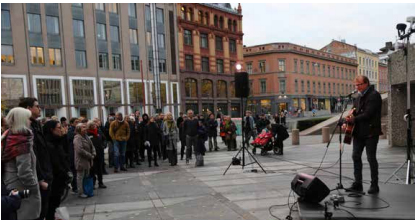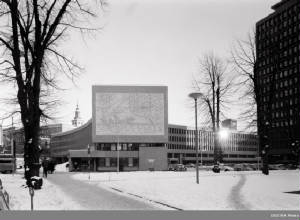Heritage Alert: Y-block Government Buildings, Oslo, Norway
[updated]
ICOMOS regrets to report that the Y-Block Government building and its associated artworks, with the exception of the two most iconic murals by Picasso which were removed and stored, were finally demolished in 2020. This disappointing outcome constitutes the biggest loss of cultural heritage in Norway since 1945, and a major blow to its post-war modernist architecture.
During its whole campaign to save this building, ICOMOS Norway was in continuous contact with Norwegian cultural heritage associations, the ICOMOS International Scientific Committee on 20th Century Heritage and the ICOMOS International Secretariat.
On 17 January 2019, ICOMOS again sent a letter to the Oslo municipality expressing its dismay that its previous letter as well as the comments submitted by the Norwegian Cultural Heritage Authority were ignored in the decision to issue a demolition permit. On 5 June, ICOMOS sent a letter to the Picasso Administration drawing its urgent attention to the fact that the demolition permit had in fact only been issued for the North wing, devoid of Picasso artworks, and urged it to withdraw its acceptance of the dismantling of the two Picasso murals – in order to save the building as a whole. On 5 July, the Planning and Building Office of Oslo Municipality issued a demolition permit covering the entire Y-Block. On 18 July 2019, ICOMOS sent a last appeal to Oslo Municipality calling for the withdrawal of the demolition permit.
On 26 February 2020, the State overruled a request to defer the implementation of the demolition permit pending the outcome of a private lawsuit brought against it.
On 24 March 2020, the Y-Block was put on Europe Nostra’s 7 Most Endangered List.
As a consequence of the demolition in 2020, the two most iconic Picasso artworks, created in collaboration with Norwegian architect and artist, Carl Nesjar, “The Fishermen,” located on the façade, and “The Seagull,” located in the interior, were removed and stored, in order for them to be incorporated in the new government quarter. Sadly, other artworks inside the building were demolished, after photographic documentation.
Currently, the new government quarter is under construction at the site. As a result, the remaining H-Block will probably lose its position as a focal point in the city.
Letters
17 January 2019, Letter from ICOMOS to The Municipality of Oslo, Planning and Building Office
5 June 2019, Letter from ICOMOS to Head of Legal Affairs, Picasso Administration
18 July 2019, Letter from ICOMOS to The Municipality of Oslo, Planning and Building Office
19 June 2018
The ICOMOS Europe Group at its annual meeting in Helsinki was very surprised to learn that the Norwegian Government is upholding its decision to demolish the Y-Block in the Norwegian Government Quarter, in spite of strong international, national and local opposition. In their declaration, the Europe Group strongly urges the Norwegian Government to reconsider its position and seek alternative solutions, respecting the universal values of the Y-Block.
26 October 2016

On 26 October 2016, a demonstration was held in front of the Y-block to protest its demolition. Musicians performed and protestors gathered around the building. Despite their efforts, State Secretary Paul Chaffey announced later that evening that the decision of demolishing would stand. The Directorate for Cultural Heritage suggested as an ultimate solution that the North wing be demolished, leaving the curve around the H-block intact.
Photo: Lars Lillo-Stenberg performing to support the protest outside of the Y-block on 26 October 2016 © Arve Henriksen
28 September 2016
The International Scientific Committee on Twentieth Century Heritage (ISC20C) of the International Council on Monuments and Sites (ICOMOS) has released an International Heritage Alert regarding the threatened demolition of the Y-block of the Government Quarter in Oslo, Norway. This action supports the conservation initiatives of ICOMOS Norway and confirms international concern about threats to the heritage significance of this important modern heritage complex in the center of Oslo.
This action supports the conservation initiatives of ICOMOS Norway and confirms international concern about threats to the heritage significance of this important modern heritage complex in the center of Oslo.
ICOMOS Norway has undertaken extensive research into this case, and confirms that the architectural and artistic merit of the Y-block, as well as its historical significance, is uncontested. Architect Erling Viksjø conceived the high-rise H-block and the lower Y-block as whole, clearly connected to similar contemporary headquarters for democratic purposes (e.g. United Nations, New York and UNESCO, Paris). The high-rise H-block was erected in 1958 with pioneering treatment of the sandblasted natural concrete and integrated works by modern artists, including contributions by Pablo Picasso. In 1969, the building complex was completed by the addition of the sculptural Y-block. Its three curved wings define three urban spaces of individual character. Picasso's "Fishermen" in one of the facades is an epitome of public art integrated within this extraordinary complex.
Download Press Release Y-block
Download Heritage Alert Y-block
Download Letter of Appeal to the Norwegian Government
Image: Y-block, Government Quarter, Oslo, Norway. Architect Erling Viksjø. Artist: Pablo Picasso.
Photo credit: © Teigens Fotoatelier, 1969-72, Dextra Photo
